
Bethany is a borough in Wayne County, Pennsylvania, United States. The borough's population was 241 at the time of the 2020 United States Census.

Waynesborough, also known as the Gen. Anthony Wayne House, is a historic house museum at 2049 Waynesborough Road in Easttown Township, Chester County, Pennsylvania. Built in 1724 and repeatedly enlarged, it was for many years the home of American Revolutionary War general Anthony Wayne (1745–1796). A National Historic Landmark, it is now a museum operated by the Philadelphia Society for the Preservation of Landmarks, offering tours and event rentals.

The David Espy House is a historic house at 123 East Pitt Street in Bedford, Pennsylvania. Built in 1770, it is significant as the residence used by President George Washington when he was leading the troops that put down the Whiskey Rebellion in 1794. It was declared a National Historic Landmark in 1983. The house is now used for commercial purposes.

The Townsend House, also known as Lundale Farm, is an historic, American home that is located near Pughtown in South Coventry Township, Chester County, Pennsylvania.

The James Finley House, also known as the Commanding Officer's Residence, is an historic American home that is located at the Letterkenny Army Depot in Greene Township in Franklin County, Pennsylvania.

Hughes House is a historic home located at Jefferson Township in Greene County, Pennsylvania. It was built in 1814, and is a 2+1⁄2-story, three-bay, banked stone dwelling. It has a small, 1+1⁄2-story extension and a steeply pitched gable roof.

Ann Cunningham Evans House is a historic home located at Caernarvon Township in Lancaster County, Pennsylvania. It was built about 1814, and is a 2+1⁄2-story, three-bay stone dwelling with a gable roof in the Federal style. It has a two-story rear ell, sun porch, and 1+1⁄2-story garage / kitchen addition.

Biever House is a historic home located in Annville Township, Lebanon County, Pennsylvania. It was built in 1814, and is a 2+1⁄2-story, 5-bay wide limestone residence in a vernacular Georgian style. It has a gable roof with dormers and a two-story, two-bay stone addition dated to the mid-19th century. The addition has a two-story frame porch.

Ross Common Manor is a national historic district that is located in Ross Township, Monroe County, Pennsylvania.

The Nyce Farm, also known as the Eshback Farm and Van Gordon House, is an historic, American home and farm complex that is located in the Delaware Water Gap National Recreation Area in Lehman Township, Pike County, Pennsylvania.
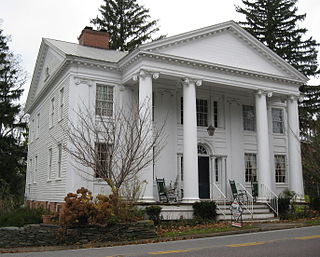
Wilmot Mansion is a historic home located at Bethany, Wayne County, Pennsylvania. It was built in 1827, and is a two-story, wood-frame dwelling in the Greek Revival style. It features a pedimented portico supported by four columns. It was the boyhood home of Congressman, Senator, and abolition advocate David Wilmot (1814-1868).
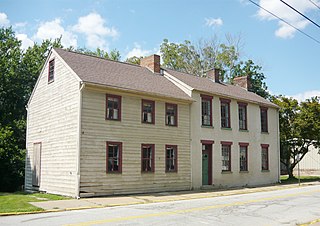
The Plumer House is an historic, American home that is located in West Newton, Pennsylvania.
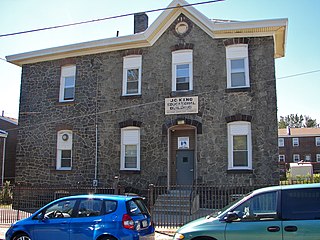
The David Wilmot Public School For Coloured Children, also known as the J.C. King Educational Building, is located the Frankford neighborhood of Philadelphia, Pennsylvania. Built in 1874, it is a two-story, four-bay, stone building in the Italianate-design presumably of Lewis H. Esler (1819-1883), a prominent architect employed by the Philadelphia Board of Public Education.

The Henry Fisher House is an historic, American home that is located in Oley Township, Berks County, Pennsylvania.
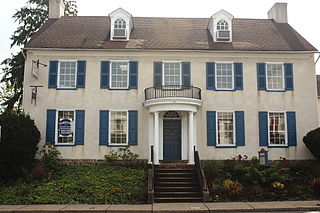
Enoch Roberts House, also known as the Trainer Mansion, is a historic home located at Quakertown, Bucks County, Pennsylvania. It was built about 1814, and is a 2+1⁄2-story, five-bay, plastered fieldstone dwelling in a vernacular Georgian style. It has an original stone rear kitchen ell. It has a gable roof with dormers added in the 1830s and a semi-circular entrance portico added in the 1940s.
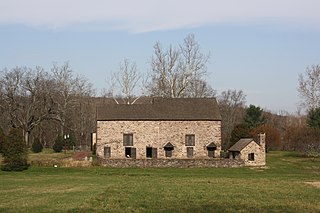
The Isaiah Paxson Farm, also known as Burgess Lea, is an historic farm complex which is located in Solebury Township, Bucks County, Pennsylvania.
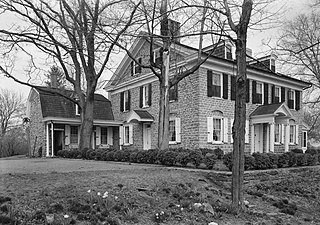
Moore Hall, also known as the William Moore House, is an historic, American home that is located in Schuylkill Township, Chester County, Pennsylvania.
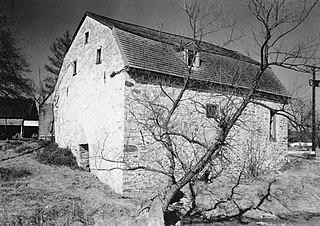
The Roger Hunt Mill is an historic, American grist mill complex that is located in Downingtown, Chester County, Pennsylvania.

Philip Rogers House, also known as Penn Wick, is a historic home located in Warwick Township, Chester County, Pennsylvania. It was built about 1750, and is a 2+1⁄2-story, five-bay-by-two-bay, random fieldstone dwelling. It has a gable roof with gable end chimneys. A 2+1⁄2-story kitchen wing was added before 1825.
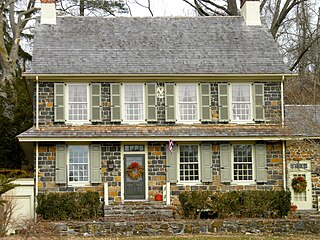
Taylor House, also known as the Meadowview Farm and Taylor–Parke House, is an historic, American home that is located in East Bradford Township, Chester County, Pennsylvania.
























